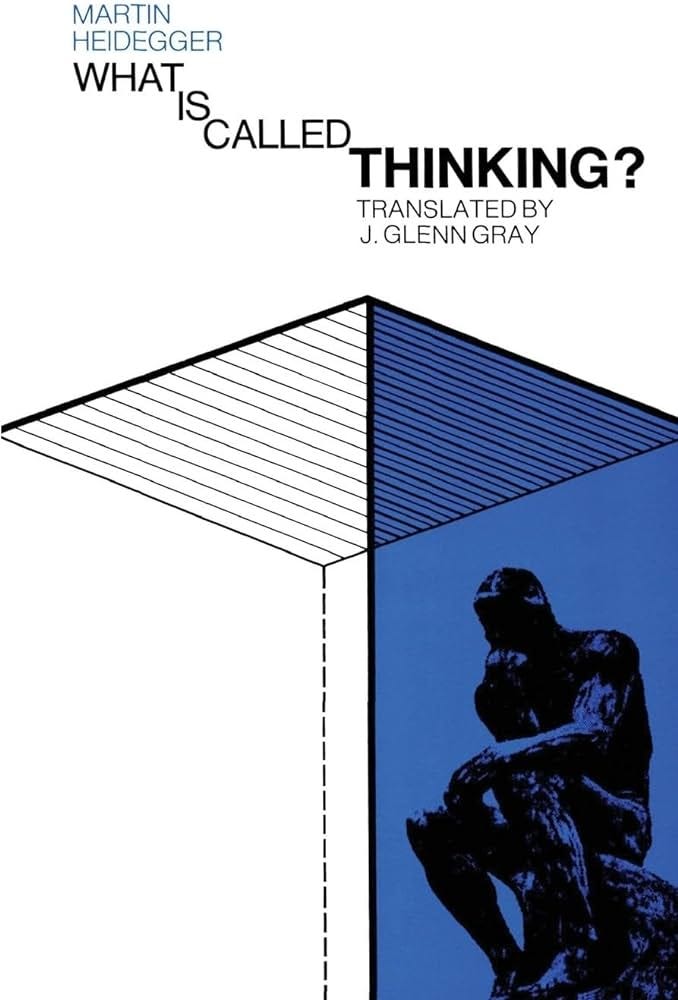What Is Called Thinking? by Martin Heidegger
About halfway through reading this book I started to dread the task of writing a review of it. What Is Called Thinking is a translation of a series of lectures the philosopher Martin Heidegger gave in the winter and summer semesters of 1951 and 1952 at the University of Freiburg in Germany.
I feel compelled here to state that I had no idea of Heidegger’s association with the Nazi party until after I finished the book. My Grandparents fought the Nazis, and raised me on a steady diet of stories of British grit and determination. As a child of the 70s and 80s, I *still* enjoy watching Indiana Jones beat, maim, and blow up Nazis. And as a life-long lover of punk rock, Nazi punks can F*&# off. I’m sure it’s just my lack of familiarity with the subject matter, but I didn’t see any kind of relationship to Nazism when I read the book, and I still don’t. That may be because Heidegger gave these lectures after having regained his legal right to teach in Germany in the early fifties. Prior to that he had lost it as a result of his dalliances with the Nazi party.
The book is only about 250 pages long, but it became clear within a few sentences that this book would be a challenge for me. I picked it up based on an offhanded comment made by Christina Pazsitzky on The Daily Stoic podcast. Doing so was akin to casually picking up a book on theoretical physics with only a basic math education. Unless one is already well schooled in philosophy, having studied Schopenhauer, Nietzsche, and Kant, the lectures are a difficult maze to penetrate and navigate.
In fact, there’s a passage toward the end of the book that perfectly encapsulates this notion that I’d had prior to reading it:
“Public opinion today cherishes the notion that the thinking of thinkers must be capable of being understood in the same way as the daily newspaper. That all men cannot all follow the thought process of modern theoretical physics is considered quite in order. But to learn the thinking of thinkers is essence much more difficult…”
Heidegger starts by asking what is worthy of thought? What is worthy of thought is thought provoking and, saving you at least 20 pages, what is most thought provoking according to him is that we are still not thinking. Heidegger invokes this idea that what is worthy of thought is hidden, and actively retreating from us, and that only by attempting to follow in the slipstream created by its withdrawal can we ever hope to find what is worthy of thought. This retreat of what is most thought provoking calls on us to think. In other words, the title of the book is a bit of word play. It means simultaneously: “What is thinking?” as well as “What calls on us to think?”
Layering multiple meanings and intents into singular expressions such that a sentence or word can mean many things at once is part of what makes these lectures interesting, but also very difficult to penetrate. It becomes apparent that Heidegger is unsatisfied with the words available to him in German to describe the concepts with which he is attempting to familiarize his students. Large sections of each chapter are dedicated to deep and confusing justifications and explanations of ancient Greek, and how modern words offering modern translations of ancient Greek do not accurately express Greek concepts or thought. Heidegger exposes layers of linguistic concepts, like digging through the fossil record, and similarly rests complex explanations on these old meanings, building up our understanding as he goes.
Since the enlightenment man has been obsessed with technological and scientific thinking to such an extent that we believe this actually *is* thinking, but to Heidegger it is not. He compares the rapid expansion of all manner of sciences to Nietzsche’s statement “the wasteland grows”. That isn’t to say he thinks science is “bad”, just that the Enlightenment has redefined thinking as rationality, and in this way, what is truly worthy of thought continues to be obscured, to withdraw from us. He suggests that the enlightenment and the associated growth of humanity along rational and scientific pathways is one side of a two-sided coin. The originating side being lost to us because our modern linguistics and understanding of what thinking is, shrouds it from us.
Heidegger then brings in Nietzschean concepts, of the Last Man and the Superman. He suggests that the Enlightenment also has an end. There is a terminus to rational thinking, represented by the Last Man, who constructs edifices of bureaucracies, process, and law with the intent of halting human progress and enshrining himself in a place of lasting and ultimate power. Contrastingly, the Superman’s nature is he who comes after the Last Man. The Superman crosses over from the rationality and scientific thinking established in the Enlightenment, to whatever comes next.
What is the difference in nature between the Last Man and the Superman? What allows the Superman to “cross over” while the Last Man entrenches himself at the end of the Enlightenment? Heidegger believes the difference is the inclination to revenge. An essential part of our nature is that we pass into the past each moment. Only the now truly exists, but with every second that passes pieces of us disintegrate into the past. The Will exists in the here and now and abhors its own passing into the past. However the nature of Being is to suffer, and the Will wills the passing of suffering (into the past). Because the Will both abhors its own passing and wills the passing of suffering it both abhors and wills its own passing, creating a revulsion. This revulsion manifests itself as revenge. Revenge is Will’s revulsion against time, specifically that the nature of time is to pass away into the past. To Heidegger what separates the Last Man from the Superman, is revenge. The Superman will have discovered what is most thought provoking, will have discovered what is called thinking, and by so doing exorcised Revenge from the soul of humanity. It is only then that we can “cross over” beyond the Enlightenment to whatever is next.
Still here? I feel I should offer snacks, a charcuterie board, or maybe a stiff old fashioned. This is heady stuff. Deep breaths.
In the second part of the book Heidegger dispenses with Nietzsche and focuses intently on the question of what is called thinking? Rather than attempt to layer and build up understanding of this answer, which I’m not sure I could do anyway, I will simply share what I believe Heidegger believes thinking is.
Thinking is constructed of these core concepts:
To ponder what lies before us.
To allow what lies before us to pull us into the slipstream of memory.
To hold together both memories and what lies before us in the now.
To keep safe from oblivion.
To offer devotion and thanks.
It is taking what lies before us (which could be anything, a tree in a field for example), and, while holding it in our minds, using it to call forth memories and thoughts of our essential nature. It is to hold the experience of now and memories of the past together at the same time, in our minds so that we can offer devotion and thanks. In this way we keep safe that which is most thought provoking from passing into oblivion.
Heidegger is saying if one could learn to truly think this way at all times (an almost impossible feat by our current modes of thinking and understanding) one would no longer be trapped by Revenge, and could ascend to the status of Nietzsche’s Superman, allowing humanity to “cross over” from the Enlightenment to whatever comes next.
I am sure that a true student of Philosophy would see my groping-in-the-dark explanation of Heidegger as sophomoric at best. I have no doubt that I do not fully understand this text and, as Heidegger suggests, the true meaning and intent of his lectures retreat from me, actively attempting to stay hidden and obscured. I don’t have the tools or experience to fully grasp the content. Even so, I’m glad I read this. In the same way that running a marathon unprepared is painful and unlikely to end at the intended finish line, even so the person got the benefit of a run.
I believe my mind has been expanded, stretched, and pushed in a way I never would have expected and so from that perspective I’m glad I read it, even if it was very painful. As the author states:
Truth is the disclosure of what keeps itself concealed. When that which keeps itself concealed, reaches its point of appearance, the byproduct is beauty.




